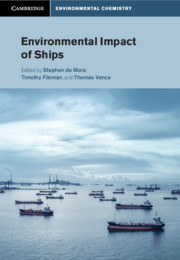Book contents
- Environmental Impact of Ships
- Cambridge Environmental Chemistry Series
- Environmental Impact of Ships
- Copyright page
- Contents
- Contributors
- Preface
- 1 Shipping, Ships and the Environment
- 2 Atmospheric Emissions from Ships
- 3 Oil Pollution from Operations and Shipwrecks
- 4 Waste and Sewage
- 5 Ballast Water
- 6 Biocides from Marine Coatings
- 7 Invasive Species
- 8 Physical Effects of Ships on the Environment
- 9 Ship Noise
- 10 Vessel Strikes and North Atlantic Right Whales
- 11 Nuclear-Powered Vessels
- 12 Environmental Impacts of Shipbreaking
- 13 International Legislative Framework
- 14 Shipping Industry’s Perspective
- 15 Environmental Impacts of Shipping
- Index
- References
7 - Invasive Species
Published online by Cambridge University Press: 22 January 2021
- Environmental Impact of Ships
- Cambridge Environmental Chemistry Series
- Environmental Impact of Ships
- Copyright page
- Contents
- Contributors
- Preface
- 1 Shipping, Ships and the Environment
- 2 Atmospheric Emissions from Ships
- 3 Oil Pollution from Operations and Shipwrecks
- 4 Waste and Sewage
- 5 Ballast Water
- 6 Biocides from Marine Coatings
- 7 Invasive Species
- 8 Physical Effects of Ships on the Environment
- 9 Ship Noise
- 10 Vessel Strikes and North Atlantic Right Whales
- 11 Nuclear-Powered Vessels
- 12 Environmental Impacts of Shipbreaking
- 13 International Legislative Framework
- 14 Shipping Industry’s Perspective
- 15 Environmental Impacts of Shipping
- Index
- References
Summary
Through the eras since life first appeared on planet Earth, biological species have been spread around the globe, both within and between landmasses and water bodies. The current biogeographical mosaic of communities and ecosystems has evolved in response to tectonic movement, climatic fluctuations and consequent sea-level rises and falls, as well as biological adaptions to the physical and chemical environment. The environmental requisites or tolerances, competitive strengths and weaknesses, mechanisms of dispersal and reproductive strategies dictate the ability of a species to survive, propagate and expand populations, with the success, speed and distances of spread governed by not only individual species traits, but also the structure of, and ecological processes within, surrounding ecosystems. Through the evolution of the biosphere, the interactions of physical and chemical conditions – and between biological species – has led to constraints on the distributions of the myriad plants and animals, with many now defined as native, or indigenous, to specific regions. Species abundances and distributional boundaries are, however, dynamic over short and long periods of time.
- Type
- Chapter
- Information
- Environmental Impact of Ships , pp. 165 - 215Publisher: Cambridge University PressPrint publication year: 2020
References
- 1
- Cited by



